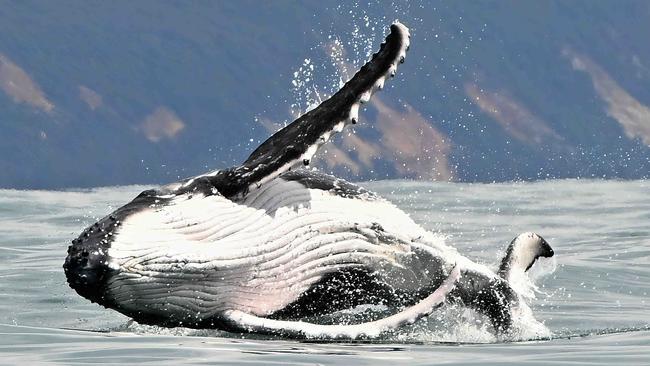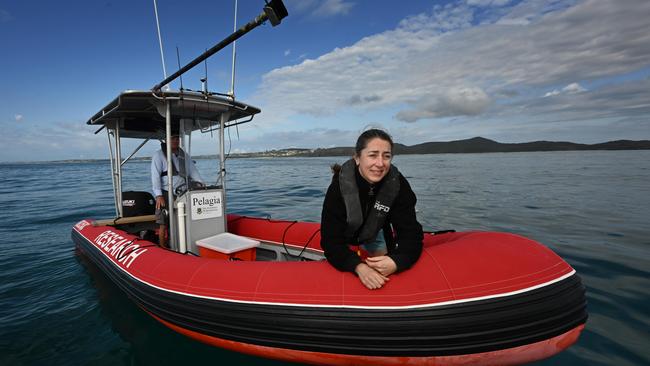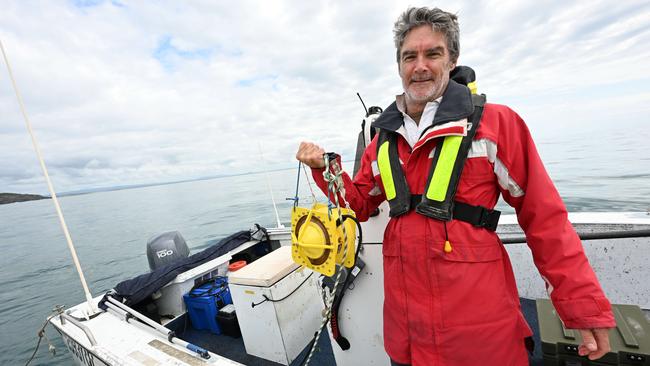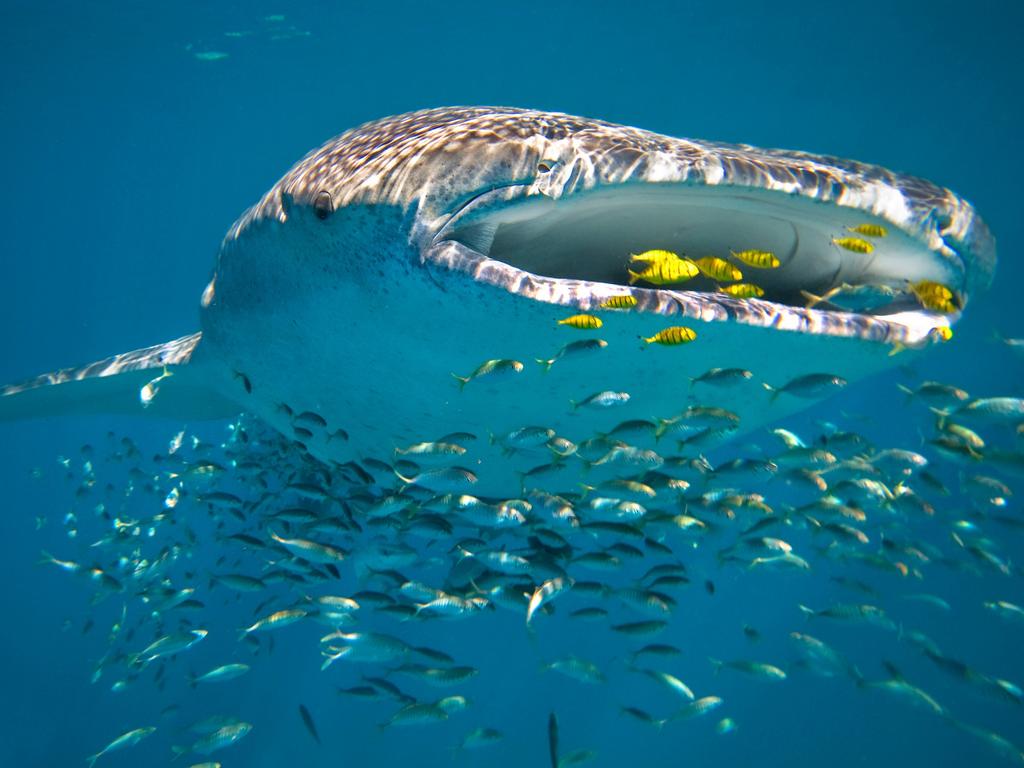Scientists edging closer to understanding whale song
After decades of listening in, two marine scientists are edging closer to understanding not only what whales say to each other in the lonely depths of the ocean, but what it means to them and us.

It’s the tail-end of peak hour, southbound, on the Pacific Highway off Noosa and this particular humpback and her wayward calf are taking their own sweet time. The secret life of whales won’t be hurried.
Rebecca Dunlop and Mike Noad have seen and heard it all before: the mighty tail slaps as the anxious mother calls the youngster back to her side; the ethereal lament of whale song at mating time; the birdlike chirps and barely perceptible rumbles used by the great creatures to communicate as they make their stately way to and from winter breeding grounds on the Great Barrier Reef.
Yet it never ceases to fascinate. And after two decades of listening in, the Brisbane-based marine scientists are edging closer to understanding not only what whales say to each other in the lonely depths of the ocean, but what it means to both them and us in our very different worlds.
So if we could have a conversation with a whale, how would it go?
Try the nursery rhyme Baa Baa Black Sheep, Professor Noad said.
“The first thing to appreciate is it’s not language because to have language for a conversation like you and I are having now we have to be able to have a lot of choice about which words we use, where, when and so on. The amount of variability we have in terms of our repertoire and the way we use it allows us to convey a lot of meaning to each other,” he said.
“A song is not like that at all. It’s locked into a pattern display of sounds, and that means you don’t actually have that much room for information in a language way.
“It would be a bit like you and I trying to hold this conversation and all we could say to each other was, ‘Baa, baa black sheep, have you any wool?’ over and over again. Obviously, that’s not very conducive to a sensible exchange.”

Dr Dunlop hates to say it, but it turns out that whales are actually a bit thick. “I really don’t think they’re quite all there,” she laughed. “They just don’t strike me as being very bright. At the same time, you know, they do have a fair bit going on. When you really delve into their social lives and acoustics they are quite complex creatures.”
This is their last day at sea in this year’s research season off Queensland’s Sunshine Coast, where the teeming procession of whales headed south to summer in the Antarctic has slowed to a trickle. Irish-born Dunlop, 45, is hoping to tag the 40-tonne female with a transponder to record its reaction to sound waves emitted from the launch. The $25,000 device attaches by suction cups to the whale’s leathery hide and, all things being equal, is to be recovered when it floats free to the surface an hour or two later.
What’s that they say about working with animals and children? Neither is co-operating. The surfaced leviathan thunderously smacks down its tail to summon the errant calf, one of the less subtle aspects of whale-speak that she and Noad, 55, have documented. They sensibly keep their distance.
He is a world authority on whale song, the melodic mating call issued by males, while Dunlop specialises in the “social sounds” attending the day-to-day interaction between the voluble humpbacks. It’s some cacophony, ranging between a low-level rumbling to shrill, birdlike chirps. “There seems to be a few stable sound types that you’ll hear year after year,” she said. “But other sound types will move in and out … they seem to have this expansive, extensive repertoire that changes and changes. Again, it suggests complexity in their interactions.”
The key to understanding this is to think like a whale, not a human, the researchers say. Take the bond between mother and calf. We would call it love, but Dunlop suspects the whale view of the relationship is more transactional. After a year, the adult female will turn loose its offspring, come what may. Until then, though, she will protect the infant whale like her own life depended on it. “Just think about the energetic cost to the mother of producing a calf,” the University of Queensland scientist said. “She has to get all the way up from the Antarctic to the GBR, get pregnant, come the whole way back down, go back up, give birth, and bring the calf the whole way back down again. That’s a serious commitment to that female. So the very, very last thing she wants is for the calf to die.
“We saw that this week. The calf got slightly separated from the mother and he was only, you know, 100m or so away. But I’ve never seen anything like it. The female just went off. I mean, she was tail slapping, she was breaching, she was going crazy. And eventually, we saw the calf do a bit of a U-turn and come back to her. So there is a bond, a tight bond for that year. But when it comes time for the mother to ditch the calf, that’s it. Gone, never to be seen again.”
Whale song is another mystery. After training and practising as a veterinarian, Noad, the director of UQ’s Centre for Marine Science, made his name in 1996 by establishing with a team of colleagues that a tune sung by humpback males off Western Australia had been picked up on the opposite seaboard. But it didn’t stop there.
A protege of theirs, Ellen Garland, of St Andrews University in Scotland, detailed in a recent study how east Australian whales had passed on songs to others in French Polynesia, which in turn gave the same songs to a third cohort in Ecuador. “Half the globe is now vocally connected for whales,” she said.

What intrigues Noad is that the song rarely stays the same: it becomes progressively more complex before being overtaken by a new and simpler refrain that starts the process over again. Why? He and Dunlop still aren’t sure. They theorise that copying error could play a part. “It’s a bit like Chinese whispers … if a song is being passed on from singer to singer and you’re only partly hearing it between some singers, that could generate some sort of variation,” Noad said.
Or it might be a male whale’s idea of bling. “While we as biologists tend to not like comparing animal things to human things it could be a bit like fashion,” he continued. “You don’t want to wear the same stuff as everyone else, you want to stand out from the crowd. That could be happening with the males to … gain female attention.”
Another UQ colleague, Jenny Allen, has explored what happens when a new song drops. How much of it is picked up, and when? This goes to the capacity of whales to learn from each other – a hallmark of human behaviour known as social learning – and forms one more strand in their expanding web of research.
A PhD student working with Noad and Dunlop, Genevieve Williams, is developing a cognitive tool to measure the capacity of whales to absorb new information during these “revolutionary events” of song change. “That will hopefully … tell us why social learning evolves in whales,” Noad said.
This, in turn, feeds into the work Dunlop has been leading off Noosa. “For me, it’s always been about cognition … the angles between cognition and defining what cognition is for whales,” she said. The transponder tags chart in three-D the response of migrating humpbacks to sound signals transmitted from the launch.
“So they might stop for a bit or they might roll and have a bit of a listen,” Dunlop said.
“We’re looking for subtle changes in their behaviour in response to that signal.”








To join the conversation, please log in. Don't have an account? Register
Join the conversation, you are commenting as Logout